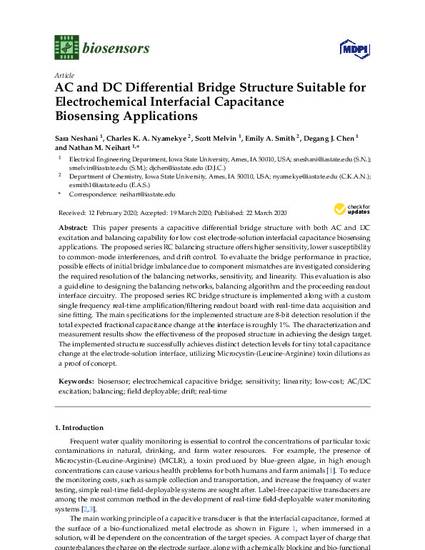
This paper presents a capacitive differential bridge structure with both AC and DC excitation and balancing capability for low cost electrode-solution interfacial capacitance biosensing applications. The proposed series RC balancing structure offers higher sensitivity, lower susceptibility to common-mode interferences, and drift control. To evaluate the bridge performance in practice, possible effects of initial bridge imbalance due to component mismatches are investigated considering the required resolution of the balancing networks, sensitivity, and linearity. This evaluation is also a guideline to designing the balancing networks, balancing algorithm and the proceeding readout interface circuitry. The proposed series RC bridge structure is implemented along with a custom single frequency real-time amplification/filtering readout board with real-time data acquisition and sine fitting. The main specifications for the implemented structure are 8-bit detection resolution if the total expected fractional capacitance change at the interface is roughly 1%. The characterization and measurement results show the effectiveness of the proposed structure in achieving the design target. The implemented structure successfully achieves distinct detection levels for tiny total capacitance change at the electrode-solution interface, utilizing Microcystin-(Leucine-Arginine) toxin dilutions as a proof of concept.
Available at: http://works.bepress.com/emily-smith/66/

This article is published as Neshani, Sara, Charles KA Nyamekye, Scott Melvin, Emily A. Smith, Degang J. Chen, and Nathan M. Neihart. "AC and DC Differential Bridge Structure Suitable for Electrochemical Interfacial Capacitance Biosensing Applications." Biosensors 10, no. 3 (2020): 28. DOI: 10.3390/bios10030028. Posted with permission.